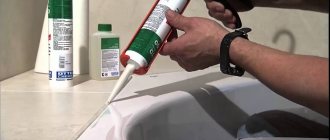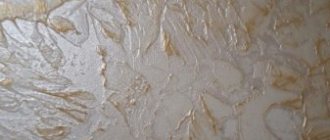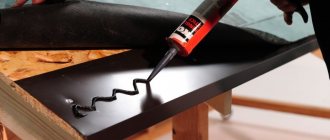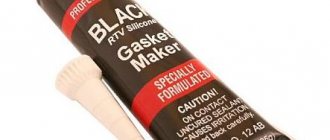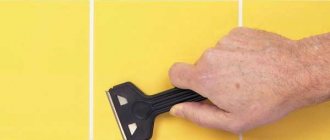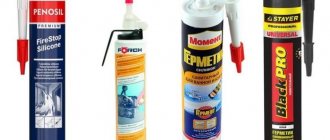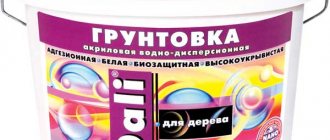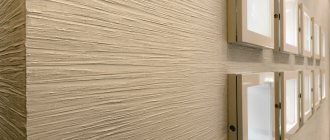Adhesive sealant for seams white
CEMMIX Adhesive-sealant for seams is a one-component polyurethane sealant for sealing various seams, junctions of steps and walls, entry of pipes and ventilation systems and rigid-elastic gluing of various materials.
More details
Since a bathroom is often designed without windows, and forced ventilation is not always provided, there is a tendency for humidity to stagnate, which can ultimately lead to the growth of mold, mildew and other unwanted microorganisms that spoil the aesthetics of the room and create an unhealthy microclimate. Microorganisms multiply especially often in seams and joints, because air penetrates there poorly, and water vapor condenses in these places.
Important!
The appearance of mold is a problem not only in the bathroom, but also in the entire apartment (house), because once the mold has started, it can be very difficult to get rid of it.
Thus, a sealant for wet rooms should be:
- waterproof;
- with excellent adhesion to different types of materials;
- resistant to mold and mildew;
- strong and durable;
- elastic;
- safe and suitable for interior work;
- easy to use and does not require complex equipment or special application conditions.
In addition to other characteristics, aesthetics are also important. The design of bathrooms and kitchens can be very interesting, but the project can be expensive, and joints made with the wrong color of sealant should not disturb the harmony. Therefore, a sealant is needed that can be color-matched or painted. Paintability is even more important since sealants have a limited palette anyway.
Sealant for gluing tiles: can it be used?
If abutments and joints require mandatory filling with sealants, the tile joints are made using special grouts, which can be cement, epoxy, cement-epoxy, polymer, cement-polymer.
For laying tiles, tile adhesive and other cement-based compounds are usually used, for example, a mixture of cement with elasticizing additives (PVA).
Tile adhesive is usually applied to the surface in a layer of a certain thickness, which provides an additional opportunity to level the surface.
You can also glue the tiles using sealant. This option has its pros and cons.
Advantages of gluing tiles to sealant:
- the ability to lay tiles on surfaces made of materials that do not adhere well to cement compounds (plasterboard, chipboard, plywood, metal);
- Can be used for moving bases (plasterboard, wood);
- ease of use;
- rapid polymerization of the composition (in some cases this is a minus, because it will be difficult to correct errors);
- Possibility of use on surfaces subject to vibration;
- easier installation of ceiling tiles;
- strength and durability.
The disadvantages of laying tiles with sealant include, first of all, the cost of the sealant, which is higher than that of tile adhesive. Also, the sealant dictates the need to work quickly and does not allow additional leveling of the surfaces.
It is not recommended to glue floor tiles with sealant because they experience increased mechanical stress. Cement-based compounds are used for flooring.
Thus, it is possible to use a sealant for gluing tiles in bathrooms and kitchens, but it is not advisable in every situation.
Advantages and disadvantages of homemade window seals
Homemade putty is cheaper than store-bought sealants. Most of the components are found around the house or sold in stores for pennies. Also, the composition of the paste is selected individually, based on the operating conditions of the window, the type of frame and its condition. Do-it-yourself window putty also has disadvantages. This is the fragility of some compounds.
You should only work with homemade sealants in warm, windless weather. This is not entirely convenient if it is cold outside and repairs need to be carried out urgently. Otherwise, such mixtures are beneficial, especially for work in the country house or utility room.
Finished product
Advantages:
- Balanced composition that is easy to apply.
- After polymerization, the putty will serve the period specified by the manufacturer.
- Reliable fastening of glass.
- Increased energy efficiency of the room is achieved.
- Long-term storage.
Flaws:
- Chemically synthesized ingredients contain toxic substances.
- Overpriced products from a factory manufacturer.
Homemade
Advantages:
- Natural, environmentally friendly composition.
- Easy to manufacture.
- Low cost of available ingredients.
Flaws:
- If errors are made during manufacturing, the putty quickly loses its performance properties.
- Extra labor costs during production.
- Some components do not respond well to sunlight and aggressive environmental conditions.
Which sealant to choose for tiles
Sealants are viscous and paste-like materials that can have different compositions and, accordingly, differ in their characteristics.
Sealants are classified according to the type of active component:
- acrylic;
- silicone;
- bitumen;
- rubber (butyl rubber);
- polyurethane;
- thiokol;
- combined.
Acrylic sealants
Despite the fact that these are environmentally friendly sealants that are available in a wide range of shades, acrylic sealants are not recommended for use in wet rooms, as well as for seams that are used outdoors. Even waterproof varieties of acrylic sealants begin to degrade when exposed to constant moisture. Another obstacle to use is the low elasticity of joints filled with acrylic sealant, which is not suitable for joints subject to deformation.
Bitumen and rubber sealants
These types of sealants are usually used for exterior work (for example, roofing).
Thiokol sealants
They are used at critical facilities (for example, hydroelectric dams).
Silicone and polyurethane sealants are most often used for bathrooms and wet rooms.
Silicone sealants
These sealants are either acidic or neutral. For work in interior spaces, only neutral varieties are suitable; acidic ones are also incompatible with metal and plastic.
The advantages of silicone sealants include the following characteristics:
- good adhesion;
- constant high elasticity, which is maintained even with temperature changes (stretching can reach 250%);
- waterproof;
- durability in enclosed spaces (outdoor service life is 5–7 years).
All these qualities make silicone sealants suitable for gluing tiles and filling joints between tiles, as well as various joints and junctions in wet rooms.
Silicone sealants are not paintable, but they are available in different shades and also in a clear version.
Important!
Silicone sealants are recommended for use on seams up to 5 mm wide. Tile joints usually have a width of 3 to 12 mm.
In general, silicone bathroom sealants are suitable and widely used.
Polyurethane sealants
Compared to other sealants, one-component polyurethane sealants stand out for their strength and durability, but these are not their only advantages.
How to seal a gap in a plastic window
One of the most vulnerable places in the house, where heat loss most often occurs, is the windows. Of course, it is impossible to provide ideal heat and noise insulation in this place, but everyone can reduce the noise level and heat loss to a minimum. The thing is that the cause of increased noise and heat loss is the cracks in the windows.
To do this, you should use a sealant. But often gaps in PVC windows arise because the rubber seal has worn out, then you just need to replace it with a new one.
You just need to remove the worn material from the grooves, clean them of dust, and then put a new seal in them. To increase its service life, it is necessary to apply silicone spray to it once a year.
The same sealant is used to cover the cracks in wooden windows. It is better to replace rotten glazing beads on such windows first. It is also good to seal the gaps formed between the sashes and the frame (or glass and frame) with synthetic adhesive tape.
Installation errors lead to a large number of problems. To avoid them, you should initially contact experienced specialists.
- Why did a gap appear between the frame and the slope? Most likely, the foam layer was not adequately protected. What to do? To solve the problem.
- Remove the old foam layer.
- Clean the gap thoroughly.
- Blow out new foam.
- Wait until it dries.
- Trim off the excess.
- Caulk the joints.
- Paint it.
- Additionally, seal the cracks with acrylic frost-resistant sealant.
This is about the question of how to cover up the cracks in plastic windows from the outside. Of course, if you do not have experience in carrying out repair work, then it is better to seek help from specialists.
What sealant should I use to seal (coat) cracks in plastic windows? You can use acrylic, bitumen or polyurethane sealant. The main thing is not to use silicone sealant; under the influence of temperatures it can roll up and become unusable.
- Silicone sealant is the most widely used.
Advantages: Color almost does not change with age. Doesn't shrink. Very elastic. Affordable in price. Disadvantages: Most silicone sealants smell like vinegar during installation. The silicone is spread over the surface with a thin film, almost imperceptible. Over time, it begins to peel off and hangs in such rags.
When you try to remove them, the entire seam follows them. The most disgusting feature of silicone is that between the frames and the slope, when the wind blows, the sealant film also sometimes hums and whistles in unison with the wind. It is the “whistle of the window” that customers complain about, and so many calls sometimes happen precisely for such a seemingly frivolous reason!
- Acrylic is rarely used now
Advantages: odorless. Also elastic. It's easy to put away when needed. Disadvantages: Almost immediately it attracts dust, collects all the dirt, and soon turns gray.
- The most common synthetic is Quilosa.
Advantages: No smell. It can be removed with water for some time after application; this is convenient for redoing, if necessary. It hardens like glue, but retains elasticity. Cleans well, even with a sponge, does not peel off. The seams are not blown through. Disadvantages: When drying, it shrinks somewhat. Therefore, you go through large seams twice. It turns slightly yellow with use. Not sold in every store.
How to seal cracks in plastic windows
We found out which putty is best to use for exterior and interior work. Now we will describe in detail how modern plastic windows are sealed. You will not encounter any particular difficulties when performing this operation.
If plastic slopes are already installed, stock up with construction tape, a sponge, a special syringe for window putty, napkins and any convenient container into which you will pour water.
- The procedure for sealing seams is given below:
- Prepare PVC slopes and frames for the upcoming procedure. Clean them from dust and dirt to increase the adhesion coefficient of the plastic. Place tape along the edges of the gaps. With its help, after completing the work, you can easily remove the remaining putty. However, the use of tape is optional. Decide for yourself whether you need it or not.
- Dissolve the silicone sealant, draw it into a syringe, and point the tool at an acute angle into the gap. Squeeze out the composition. The nose of the syringe will immediately smooth out the assembly seam (but only if you hold it strictly at an acute angle).
- Excess putty that appears on the surface of the gap should be carefully smoothed with your finger, after moistening it in water. Here it is important to distribute the sealant as evenly as possible along the seam. There should not be even the smallest voids left.
- Use a napkin to wipe the putty off your finger. Take a sponge, wet it, and carefully remove excess sealant from the surface of the seam. Perform the operation very carefully. The laid layer of putty must not be damaged. Rinse the sponge in a container of water frequently. Then it will not cling to the main layer of the assembly seam.
Advice.
Seal window openings in stages. Treat one small area first. Remove the mastic from it. Then move on to the next section. The putty hardens fairly quickly. If you immediately fill a gap that is large in length and area, you may not have time to properly level the composition. The final work is to clean the slope and window frame from putty. Remove the tape, if you used it, and remove any remaining sealant. A small nuance: degreasing and cleaning window openings cannot be carried out with acetone solutions.
They leave clearly visible streaks and stains on PVC structures. It is recommended to clean slopes and frames with white spirit.
Sealant for window seams
The modern construction market offers a huge variety of all kinds of materials used for repairs and similar activities. This also applies to sealants for plastic (PVC) window products. Such compositions are understood as a plastic paste-like mixture created on the basis of certain polymers.
Any sealant for window seams hardens when applied to the surface being treated, resulting in a special moisture-resistant and airtight layer being formed. The latter reliably protects plastic structures from temperature changes and atmospheric influences, and gives the windows an attractive appearance.
- Sealant for plastic windows is:
- silicone;
- polymer;
- acrylic (acrylate);
- butyl;
- polyurethane;
- thiokolov.
All of these compositions can be used for sealing slopes, various gaps remaining on window (PVC and conventional wooden) structures after installation work, for additional noise and waterproofing.
At the same time, different types of sealants are characterized by their own strength indicators, adhesive and other performance properties. Let's try to figure out which mixtures are optimal for working with plastic windows.
Sealing compounds for external use
Acrylic mixtures are in most cases used to refine installation joints located outside the room. It is not advisable to use them for interior work. Sealing windows with acrylic sealant protects PVC products from the harmful effects of rain and snow, as well as ultraviolet radiation.
The compositions that interest us in their frozen form have a porous structure. For this reason, they are not used indoors. The porous surface at the seams easily absorbs fumes coming from living quarters. After some time, the acrylic putty begins to darken and lose its sealing properties.
Butyl sealant is also used to seal external seams. It is a rubber-like composition, made of polyisobutylene, and is characterized by high elasticity and elasticity. Such mixtures are absolutely safe for human health.
They have increased resistance to solar radiation and can be used at extreme temperatures (from +100 to –55 °C). An important advantage of butyl compositions is almost one hundred percent vapor permeability. This allows them to be used not only for sealing wooden and PVC frames, but also for restoring double-glazed windows.
Thiokol mixtures are created on the basis of polysulfide special compounds. Due to this, the sealant is able to harden in any weather conditions. It is guaranteed to set at high humidity, low temperature. Most often, thiokol compounds are used in cases where cracks are sealed in rainy weather or in winter.
Polyurethane sealant has approximately similar properties. It adheres to any substrate without any problems. They seal seams between wooden and metal-plastic frames. If desired, the polyurethane mixture (strictly after it has completely hardened) can be varnished or painted in any desired shade.
What sealant for external seams can be called the best? It all depends on what time of year the gaps are sealed and the slopes are improved, and what special requirements are put forward for the installation composition. If work is carried out in autumn or winter, it is advisable to use thiokol, polyurethane compounds.
In areas with large temperature differences, it is recommended to use butyl sealants. Acrylic mixtures allow you to minimize the financial costs of sealing external seams.
Polymer and silicone putties - ideal for internal use
Indoors, theoretically, any of the sealants described above can be used. But often this is simply not necessary. You will overpay for features that are absolutely unnecessary. To seal window gaps inside apartments and houses (and partly for insulation), it is wiser to choose a polymer or silicone sealant.
The first of these is often called liquid white plastic, since it is made on the basis of PVC polymers and is characterized by high viscosity and excellent adhesion to plastic products. This composition, after filling the gaps, creates a monolithic structure with the window.
It should be noted that white sealant based on polymer substances cannot be used in situations where any serious load is placed on the assembly seams. The composition does not have sufficient strength.
In such cases, there is a high probability of seam rupture. Another disadvantage of polymer putties is their high cost. It is completely justified. The sealant has truly high-tech characteristics. It can't be cheap.
White silicone window sealant is more affordable and yet effective in use. It is made from organosilicon components, which give the finished product excellent adhesive capabilities and high elasticity.
This putty does not change its color during use (remains white even 10 years after treatment) and does not shrink. Working with silicone for window openings is very simple.
Any home craftsman can seal seams with its help. The silicone-based composition is easy to apply, hardens well and quickly. Minimum problems and guaranteed results of waterproofing and sealing seams.
Please note that there are two types of silicone - neutral and acidic. There is no significant difference between these compositions. Acid sealant for PVC windows emits a barely perceptible smell of table vinegar after use.
This scent dissipates fairly quickly. The neutral silicone composition for plastic structures and wooden window frames has no foreign odors.
White sealant for plastic windows, which is better?
Within a few years after installing PVC windows, home owners begin to notice that the initially white stripes of sealant have acquired a gray or yellowish color. Problems can also arise after washing the windows - the stripes begin to flake and sag in completely undecorative flaps, which, moreover, are very difficult to remove with your own hands.
However, not all sealing compounds have such qualities. It’s just that most consumers, and even builders, do not know an alternative to the already familiar “silicone”. This is where we will begin the review. Silicone sealants are the most widespread and affordable. After hardening, the strip does not shrink and retains its elasticity and color for many years.
The unpleasant smell quickly disappears during installation, but this is not the only drawback. When installing PVC windows, very often invisible films form on the glass, which over time peel off and hang in rags. Don't try to tear them off - you can remove the entire seam with your own hands.
But this is not the worst thing - if between the surfaces (window frame and slope, frame and glass) during the installation or assembly of the PVC window, gaps were left through which the wind can penetrate, with strong gusts the window will begin to “whistle”, hum and howl. So if strange sounds appear in your house, this is not the ghost of a deceased great-grandmother at all, but just a window.
However, you need to understand that a mistake was made during the installation or assembly of the PVC window, and this problem must be solved in these directions. You also need to remember that not all types of silicone sealants can be painted. Sealing plastic windows with acrylic sealants yourself will cost almost the same as in the previous case.
The problem with acrylic compositions is color change. White due to dust and dirt can turn into gray in just a few days. Therefore, if you use acrylic sealant, it is to seal seams and cracks that are hidden from view, and to seal the gaps between the window opening and the frame.
This product has low vapor permeability, so it is ideal for protecting polyurethane foam from moisture. When used, the acrylic composition produces virtually no odor.
Adhesive sealant for seams white
CEMMIX Adhesive-sealant for seams is a one-component polyurethane sealant for sealing various seams, junctions of steps and walls, entry of pipes and ventilation systems and rigid-elastic gluing of various materials.
More details
White facade adhesive sealant
CEMMIX Facade adhesive-sealant is a special sealant based on hybrid polymers for various joints.
More details
For gluing tiles, sealing joints between different materials, as well as joints that are subject to deformation, the most suitable option is an adhesive-sealant, for example, one-component Cemmix adhesive-sealant for seams based on hybrid MS polymers. Let's look at the characteristics of this high-tech sealant, designed for rigid-elastic gluing of different types of materials and filling seams up to 20 mm wide:
- release form - in tubes;
- does not require mixing of components, completely ready for use;
- For application you need a construction gun;
- Application is simple, the adhesive-sealant does not bubble or spread;
- high thixotropy allows you to conveniently work on vertical and reverse horizontal surfaces;
- initial curing occurs within 15 minutes;
- adhesive-sealant demonstrates high adhesion to any type of material;
- compatible with any building materials;
- works on wet surfaces;
- does not require preliminary priming of surfaces;
- waterproof, chemically inert, resistant to mechanical stress, vibration, high and low temperatures;
- does not support the growth of fungus and mold;
- elastic;
- lasts 10–25 years even when used outdoors while maintaining all declared characteristics;
- Available in four shades (black, white, gray and brown), the seams can also be dyed.
Important!
Polyurethane sealants are also the material of choice for replacing old joints.
Traditional methods
Often simpler methods are used to remove sealant from tiles, using various products that are available at any home.
Options:
- kerosene;
- petrol;
- White Spirit;
- acetone;
- nail polish remover.
There are many reviews on the Internet of people who have used this, claiming good results. Such reviews are deceptive, do not forget that a good option is rather an exception. Usually, everything doesn’t turn out as well as possible, the dirt is not washed off completely, and in some cases new stains even appear, which only further spoil the appearance of the room being repaired. Experts strongly do not recommend resorting to such methods. If you need to soften the silicone in order to then remove the softened form using mechanical action, then here’s how to remove the sealant from the tiles - use regular kerosene. Please note that the room must be well ventilated, otherwise an unpleasant odor may remain.
Why do you need colored sealant?
The purpose of interior decoration is to make them not only functional, but also aesthetically attractive. There are so many seams in the bathroom and kitchen that, according to the laws of design, you need to play with them to benefit the appearance. For this purpose, sealants are selected to match the tone or, if this is difficult to do, a color that is harmoniously combined with the shade of the tile is selected (nuanced, contrasting).
Chemical option
The second option for removing silicone sealant from tiles, which is often the most effective, is the option that involves the use of chemicals. This makes it much less likely that you will cause any damage to the tiles or seams, and there is also less labor involved. Many people choose this option. More precisely, there are extremely many options and approaches here. Let's look at the main ones.
There are several popular brands, in particular Lugato, Quilosa and a number of others, it is difficult to recommend something specific, the main thing is to look for it to be a specific sealant solvent, and not some universal, less effective product, or a solvent intended for other purposes .
Typically, such solvents are available in the form of a paste or aerosol. Under their influence, silicone turns into a soft substance, which is then easily washed off or softened to such an extent that it can be simply removed. This is a very simple method on how to remove silicone sealant from tiles.
Please note that the solvent can also affect the varnish/paint/enamel; before use, it must be checked in some inconspicuous place.
Adhesive sealant for seams white
CEMMIX Adhesive-sealant for seams is a one-component polyurethane sealant for sealing various seams, junctions of steps and walls, entry of pipes and ventilation systems and rigid-elastic gluing of various materials.
More details
Adhesive sealant for seams, gray
CEMMIX Adhesive-sealant for seams is a one-component polyurethane sealant for sealing various seams, junctions of steps and walls, entry of pipes and ventilation systems and rigid-elastic gluing of various materials.
More details
Adhesive sealant for seams black
CEMMIX Adhesive-sealant for seams is a one-component polyurethane sealant for sealing various seams, junctions of steps and walls, entry of pipes and ventilation systems and rigid-elastic gluing of various materials.
More details
Gray, white and black colors are achromatic and go well with any shade. To fill tile joints, you can also use Cemmix facade adhesive-sealant, which is available in eight shades (white, gray, black, brown, beige, green, blue, red).
Price
The most affordable are acrylic compositions, prices for which start from 150 rubles per 1 kg. Two-component polyurethane ones cost from 172 rubles per 1 kg. Thiokol products cost from 192 rubles per 1 kg. Silane-modified sealants are produced in tubes, the price of one is from 695 rubles.
The specific cost depends on the manufacturer and the store where the product is sold.
White facade adhesive sealant
CEMMIX Facade adhesive-sealant is a special sealant based on hybrid polymers for various joints.
More details
If the shade of the sealant does not fit into the designer’s plan, then the seam can be painted after conducting a preliminary test for compatibility with paints and varnishes.
Important!
Tinting powders and pastes must not be added to sealants!
What not to use
Many people believe that it is possible to remove silicone with some of the universal household cleaners. In reality, this is a rather serious misconception - a bad option than washing off the silicone sealant from the tiles. There will usually be no result; in the worst case scenario, the situation will worsen quite seriously.
Another remedy that you should not resort to is vinegar. People's logic is usually similar - since silicone smells a little like vinegar, then this product with the same smell is effective against it. This is a false, unfounded statement that misleads people. If you use vinegar, no results will appear; you will waste your time.
How to waterproof a bathroom
To properly fill the junctions and joints with polyurethane sealant, you need to prepare the base - clean it and remove dust. If the surface is fragile, consider using a primer.
A polyethylene foam cord is placed at the mouth of the seam to eliminate the third contact surface. Adjacent surfaces are covered with masking tape, but if you are confident in your abilities, you can apply the sealant “by hand”; it does not spread and is easily adjusted with a spatula soaked in soapy water for 15 minutes after application.
Apply the sealant using a regular construction gun, using a gentle, slow movement in one direction, and smooth the seams with a spatula, remove excess material and remove air bubbles.
After applying the sealant, the masking tape must be immediately removed, as well as excess material and application flaws. The final polymerization of the sealant will occur under the influence of moisture from the air in about a day, after which the seams will become strong.
Polyurethane sealant is a necessary material when performing finishing work in the bathroom and other wet areas. It is used not only for sealing seams, but also for gluing tiles. You can buy reliable Cemmix Seam Adhesive-Sealant and Cemmix Facade Adhesive-Sealant in Moscow and other cities wholesale, retail, online.
You can buy CEMMIX products without leaving your home, with discounts from 5 to 33%!!!!
Buy on Ozon
Buy on Yandex.Market
Buy on Wildberries
Buy at Leroy Merlin
Or you can find the nearest official dealer in your region on our map
← Waterproof and frost-resistant metal sealant for exterior use
Frost-resistant and waterproof sealant for exterior use →
Return to list
Comments
Mechanical approach
If the silicone layer is large enough and thick enough, a sharp object is enough to cut it off the coating. This is a simple and straight forward method on how to remove sealant from tiles. There are many options for tools that can be used for this.
Here are the main ones:
- Scraper. Plastic/wooden, suitable for kitchen (intended for frying pans). A glass scraper will do.
- Wire wool. An option is a wire dish sponge.
- Knife. The sharper the better, but there is a greater chance of damage to the surface, it is critical to approach very carefully. Many people prefer to take an ordinary stationery knife, as it is especially sharp, but not too “scratchy”. Another option is a razor, or rather a blade. Here you need to be especially careful, wrap the razor with cloth so as not to cut yourself on its edge.
- Dry burlap rags - after you wash/peel off the sealant from the tiles, you need to wipe off any remaining residue.
- Eraser.
- A brush designed to sweep away silicone residue.
Usually they don’t choose just one thing to use to remove the sealant from the tile, but use several tools at once - first they cut the layer with a knife, then tear off most of it with a scraper, then clean everything off, for example, with an eraser or a washcloth.
Try to peel off the silicone with a scraper clearly but smoothly, choosing the optimal angle of the tool in relation to the tile.
News
We are always ready to help
Cemmix has opened a free hotline
to help you with any questions related to construction using concrete additives. Call and ask, our consultants are always ready to help!
Hyperplasticizer
Hyperplasticizers are a new type of plasticizing additives for concrete, ensuring the mobility of the mixture above P5. In addition to plasticity, they increase the water resistance and frost resistance of concrete by 2-3 times.
Rules of application
Do-it-yourself insulation of wooden windows using sealant is carried out using the following technology:
- remove irregularities, peeling paint and treat the work area with fine sandpaper;
- degrease the surface with a solvent;
- unpack the cylinder, insert it into the gun (it is possible to carry out work without this tool);
- squeeze out the composition so that it covers the surface to be treated with a thin line (the gap must be completely closed);
- remove excess substance, cover with cling film;
- wait until the composition dries (this takes about 5 hours);
- Remove the film and trim off the excess with a utility knife.
Compliance with the instructions will ensure quality work. The tightness of the structure depends on this.

